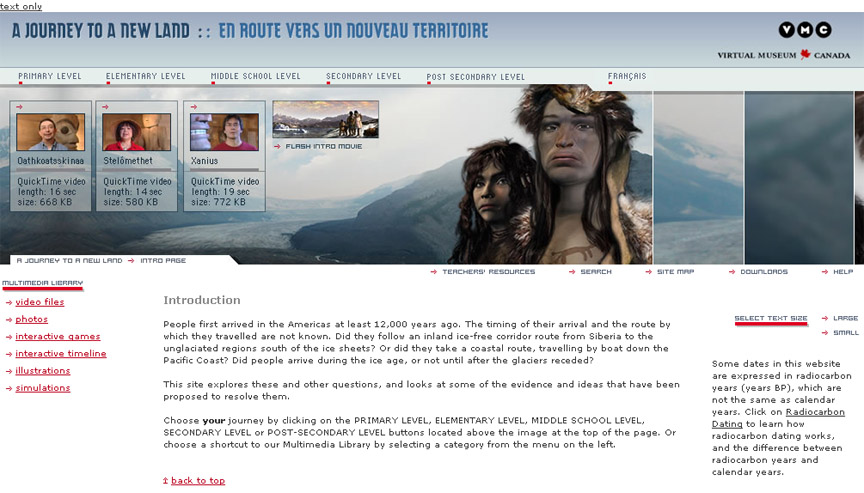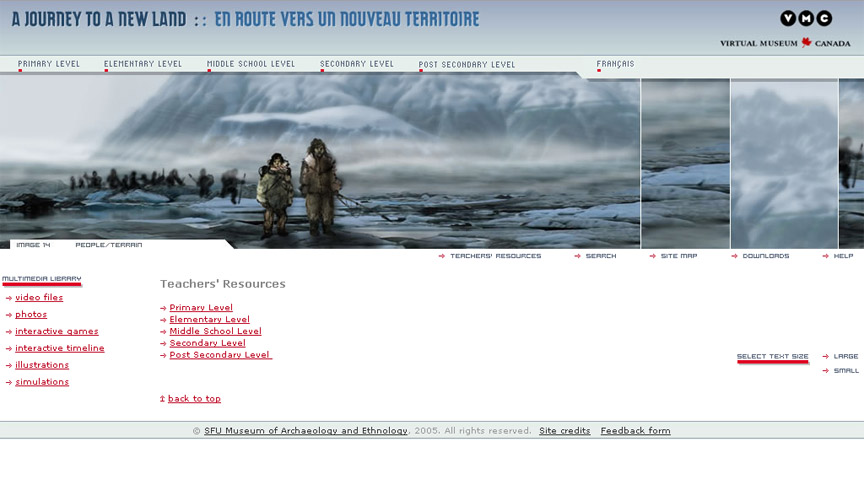
Figure 1: Screen shot of the homepage; navigation is easy, presentation is clean.
Curator of Ontario Archaeology, Canadian Museum of Civilization. Email: Jean-Luc.Pilon@civilisations.ca
Cite this as: Pilon, J-L. 2007 Review of the Website A Journey to a New Land, Internet Archaeology 21. https://doi.org/10.11141/ia.21.6
A Journey to a New Land is a multi-media website which uses PDF, Quicktime and Flash as well as HTML. http://www.sfu.museum/journey/
Archaeology and Traditional Knowledge sometimes find themselves pitted against each other in the quest for legitimacy, for an audience. When discussing the origins of the Native populations of the Americas, some very serious emotions can be touched upon. You only have to revisit the whole question of the Kennewick Man controversy over these past few years to see how this "contest" came down, quite literally, to fighting over the bones of these ancient people. On the one hand, scientists had a wonderful opportunity of studying very scarce remains dating to the pre-8500 year ago period. Yet local Native Americans invoked NAGPRA (Native American Graves Protection and Repatriation Act) to claim the remains as their own and insist on their reburial and especially their withdrawal from scientific study. Judges and lawyers got into the fray and arguments were advanced in front of tribunals. Does this mean that archaeologists should shy away from discussing the issues, from laying out what evidence does exist to advance one theory over another? Absolutely not. In fact, the contrary is clearly indicated. We need to enter into a dialogue (well outside of the legal system, I would hasten to add) and we have to ensure that the public has access to as much information as possible in order for their opinions to be better informed because public opinion, whether we like it or not, influences the political and even the legal processes that can and sometimes do impinge upon archaeological inquiry.
A Journey to a New Land is part of the Virtual Museum of Canada, a gateway into Canadian museums sponsored by the Department of Canadian Heritage. It was produced by the Simon Fraser University Museum of Archaeology and Ethnology in Burnaby, British Columbia, Canada.

Figure 1: Screen shot of the homepage; navigation is easy, presentation is clean.
A Journey to a New Land is an attempt to accomplish the very important goal of educating people about the process and recent results of archaeological research as regards the whole question of the first peopling of this continent. The intent of this bilingual (French and English) multi-media site is to offer pertinent information to educators at different levels in British Columbia. It does not purport to provide definitive answers, but to lay out some elements of the current theories and promising new avenues of research that are currently being tested and undertaken.
The geographical focus of the archaeological information relating to the proverbial first journey described in this website is primarily British Columbia where some very important sites have been found and where cutting edge research is currently taking place.
The traditional, conventional archaeological models of the peopling of the American continent have long favoured a "Mackenzie Corridor" route which would have opened up at the very end of the last glaciation. There have always been problems with these models such as the lack of adequate precursors to Clovis on the "other side of the ice" at an earlier time, or the extreme nature of the environmental conditions within the "Corridor" that people would have had to contend with as they dashed through on their run to the south.
However, over the past few years, the possibility of a coastal route that would have skirted the Cordilleran Ice has gained a number of adherents and has garnered a growing interest in underwater archaeological research along the submerged shelf of the Pacific coast. Moreover, with a growing interest in the possibility of pre-Clovis occupations south of the Laurentide glacier, a coastal migratory route appears more and more attractive.
While the story being presented is basically an archaeological one, it could not be recounted without presenting a fair amount of information from sibling sciences, especially geomorphology, glacial geology and radiocarbon dating.
Developing serious archaeological content for a wide range of school levels is not an easy task. As different school levels require information adapted to them (the educators as well as the students), this website provides targeted learning outlines for various school levels in the British Columbia curriculum: primary, elementary, middle school, secondary, post-secondary (as a non-British Columbian, I am not quite certain how these levels compare with levels in other Canadian provinces and some indication of the age range covered by them would be useful for me to understand the appropriateness of the information provided). Each level follows its own tailor-made journey. Teachers' resources have outlines that use a language appropriate to the students and suggested activities, questions, themes for exploration in the classroom, as well as supporting resources suitable to each level: illustrations, videos and animations. A glossary of terms also provides an important bridge between the science and the classroom.

Figure 2: Screen shot of the teachers' resource page, which is also always accessible above the banner illustration across the top of all pages.
One feature that I particularly liked about the site was the presentation of interviews with specialists on particular topics. I think the value of these videos is to see the face of the scholar, to see that they are regular people. However, there is very little actual editing of the videos and frankly some could have benefited enormously by using illustrations and photographs of the features being discussed and narrated by the researchers. It must sometimes be very hard for a youngster to imagine what the scientists are in fact talking about.
To view these videos, I had to open them from home since my employer's firewall did not allow my viewing of them. This was, thankfully the only portion of the site that our overzealous firewall prevented me from accessing.
I am reminded of a website (http://paleoassociation.ifrance.com/paleoassociation/) put together by La Paléoassociation of the Université Paul Valéry in Montpelier, France. It was a very innovative presentation of specialists actually giving talks (as downloadable wav files) on a particular excavation they had taken part in. You could tell that they were locked in a sound booth with no audience, so they seemed very relaxed. They may or may not have had prepared texts in front of them. They generally spoke about the site, referring to photos which were downloaded in a separate window and numbered. This way, the audio referred to image 2 and you easily scrolled down to it. There was an intimacy which was very special and engaging. Unfortunately, they have not posted any new conferences in five years and only two remain accessible. The format remains a very interesting way of making specialists and specialized information available.
There is a great challenge (not the least of which is financial) in presenting essentially the same data set for many very different audiences. Do you produce one information level or tone, but only make certain subsets available to different users? For example, in A Journey to a New Land, post-secondary level students should be able to work their way through site reports for Charlie Lake Cave while this would be a complete misuse of resources for primary students. At the same time, perhaps the primary teacher might be able to benefit from detailed information. In this case, I think they targeted the middle of the range. It is important to remember this when you come upon the interactive games, the opening video and even the screen savers. They are primarily designed to captivate the attention of someone who perhaps would not otherwise be interested in such things. I think they manage quite well.

Figure 3: Screen shot of the Primary Level Teachers' Resource page with links to additional resources.
The pages are clean and navigation very easy. Lots of hot terms or phrases open new windows with additional information or illustrations. You won't get lost in this new land.
I do believe that the website will be very helpful for teachers at most levels in British Columbian schools. I suspect it may be less useful at the post-secondary level, however, since the depth of information just is not there. At the same time, this particular website goes into much more depth with respect to the study of the coastal migration route than do most other websites that I am familiar with and in this respect, it is a valuable resource for all teachers outside interested in learning the coastal route option.
Internet Archaeology is an open access journal based in the Department of Archaeology, University of York. Except where otherwise noted, content from this work may be used under the terms of the Creative Commons Attribution 3.0 (CC BY) Unported licence, which permits unrestricted use, distribution, and reproduction in any medium, provided that attribution to the author(s), the title of the work, the Internet Archaeology journal and the relevant URL/DOI are given.
Terms and Conditions | Legal Statements | Privacy Policy | Cookies Policy | Citing Internet Archaeology
Internet Archaeology content is preserved for the long term with the Archaeology Data Service. Help sustain and support open access publication by donating to our Open Access Archaeology Fund.